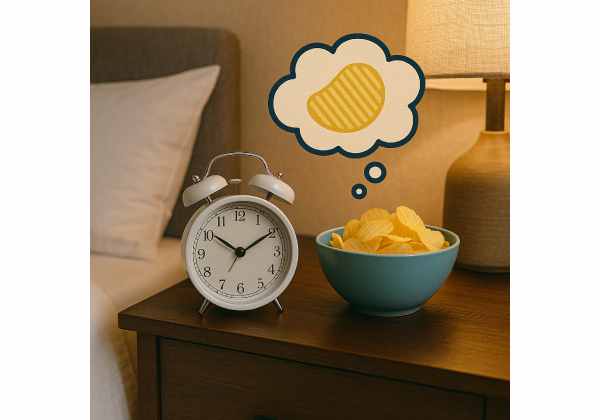
Late-night snacking is rarely about hunger alone. It is a mix of timing, habit loops, stress, and an environment that nudges you toward easy calories when willpower is low. The fix is not white-knuckling the pantry; it is redesigning cues, timing meals so cravings fade, and giving yourself better defaults at 9–11 p.m. This guide shows you exactly how. You will get a practical “tonight plan,” daytime habits that make evenings calmer, and templates for common routines like TV nights or shift work. If you want a broader framework that ties these moves to sustainable change, skim our concise primer on habit, sleep and stress basics for weight loss.
Table of Contents
- What late-night snacking does
- How to stop late-night snacking tonight
- Daytime fixes that prevent night eating
- Common mistakes and quick fixes
- Safety, medications and special cases
- Evidence and what results to expect
- Routine templates you can copy
- Frequently asked questions
What late-night snacking does
Late-night snacking is not just “extra calories.” It reshapes your next 24 hours. When you graze at night, sleep can fragment, morning hunger swings, and afternoon cravings get louder. That cycle—poor sleep → stronger cravings → more snacking—keeps many people stuck even when their daytime eating looks reasonable.
Why evenings are a hot zone
- Biology shifts. Insulin sensitivity tends to be lower at night. Big, sugary hits create sharper spikes and dips that fuel “one more bite.”
- Decision fatigue peaks. You used discipline all day. By 9 p.m., the brain prefers defaults over decisions.
- Environment cues fire. Couch + TV + opened pantry is a learned loop. If sweet food “lives” after dishes, your brain expects it whether you are hungry or not.
- Sleep pressure vs. stimulation. Bright screens, late caffeine, and stress hold your arousal up right when your body is trying to wind down. Food becomes an easy self-soother.
How this impacts weight loss
- Unplanned calories: Night calories often land on top of the day’s intake rather than replacing anything.
- Hunger the next day: Poor sleep increases appetite and sweet cravings, making breakfast and lunch harder to manage.
- Motivation erosion: Night guilt prompts daytime restriction, which backfires by evening. The pendulum swings.
What actually changes the pattern
- Boundaries, not bans. A planned “sweet finish” beats open-ended grazing.
- Timed gaps. A 20-minute pause after dinner lets appetite signals settle and turns impulses into choices.
- Protein and fiber anchors. A steady dinner (protein + veg + starch) reduces the urge later.
- Light and caffeine hygiene. Dim lighting and an earlier cutoff move your biology toward sleep, not snacks.
Where this fits in your bigger plan
Weight loss responds to steady, repeatable habits—sleep, protein, movement—more than heroic days. If you need a simple roadmap to pair with your evening strategy, our safe weight loss guide shows how to set targets you can keep.
Bottom line: Late-night snacking is a systems issue, not a character flaw. When you change the inputs, the urge drops and your evenings get quiet.
How to stop late-night snacking tonight
You can make tonight easier without overhauling your entire diet. Use this five-part sequence. It takes 20–30 minutes and addresses hunger, habit, and environment together.
1) Build a steady dinner (the foundation).
Use the plate method: half vegetables, a palm or two of protein (25–40 g), a cupped handful of starch, and a thumb of fats for flavor. This combo slows digestion and steadies glucose so cravings fade.
2) Close the kitchen with a “sweet finish.”
End dinner with a planned small sweet anchored by protein:
- 170 g Greek yogurt with berries and cinnamon.
- Protein pudding (protein powder + milk) with a few chocolate chips.
- Baked apple with cinnamon; optional spoon of yogurt.
Make it visible, enjoy it, and put everything away. A boundary beats a ban.
3) The 20-minute timer.
Set a timer after dinner. Tidy the kitchen, prep tomorrow’s breakfast or lunch, and sip peppermint or chamomile tea. When the timer ends, check: would a balanced snack sound good? If yes, eat one small structured option (see below). If no, it was a craving—shift to a non-food routine.
4) If-then choices (no negotiations).
- If I feel snacky and I would eat yogurt or an apple with peanut butter → have that, then stop.
- If only cookies sound good → take a shower, stretch, or read for 10 minutes. Cravings crest and fall like a wave.
5) Lights and screens.
Dim lights, turn on night mode, and place your phone to charge away from the couch. A darker, quieter environment supports “sleepy” signals over snack cues.
Green-light evening snacks (if you are truly hungry)
- Cottage cheese and pineapple.
- Whole-grain toast with peanut butter.
- Edamame and an orange.
- High-protein hot chocolate made with milk.
Make success easy
- Portion trigger foods into single servings—or keep them out of sight.
- Brush teeth after the sweet finish to send the “kitchen closed” signal.
- Walk 10 minutes after dinner; movement reduces the urge for a second dessert.
For fast, ready-to-use options, save our protein and fiber quick fixes so there is always a satisfying alternative at hand.
Daytime fixes that prevent night eating
Evening snacking often reflects daytime gaps. Patch the day and nights calm down.
Anchor protein early.
Start your first meal with 25–35 g of protein (eggs, Greek yogurt, cottage cheese, tofu scramble). This reduces late-day snackiness and keeps dinner portions steady.
Predictable meal spacing.
Long gaps lead to arriving ravenous, then overshooting, then grazing later. Most people do well with three meals and one planned snack, or four smaller meals spaced 3–4 hours apart.
Front-load fiber and volume.
Aim for 25–35 g of fiber daily; hit half by mid-afternoon. Add vegetables, beans, and whole grains to lunch so you are not negotiating with cravings by 8 p.m.
Hydration rhythm.
A glass on waking, mid-morning, at lunch, mid-afternoon, and with dinner. Dehydration often masquerades as snackiness.
Caffeine timing.
Enjoy coffee early; set your personal cutoff 8–10 hours before bedtime. Late caffeine pushes sleep later, and poor sleep pushes snacks higher.
Movement cues.
Post-lunch or post-dinner 10-minute walks steady energy and regulate appetite. Stack them onto your existing routines (finish dishes → walk).
Environment priming at home.
- Keep sweets in opaque containers and high shelves.
- Place “green-light” snacks at eye level.
- Pre-portion treats if you keep them—one serving is a treat, the package is a plan.
If you want a framework that organizes meals around appetite rhythms (not strict calories), skim our guide to meal timing for appetite control and steal the parts that fit your day.
Common mistakes and quick fixes
Skipping dinner or going too light
A tiny salad sets you up for a 10 p.m. pantry raid. Build a full plate with protein, veg, and starch so you do not go hunting.
“Saving calories” for dessert
Arriving at the couch hungry turns dessert into a free-for-all. Eat a real dinner, then a planned sweet finish.
Keeping trigger foods visible
Transparent containers invite grabs. Use opaque bins and put single-serves behind protein options in the fridge.
Leaning on zero-calorie sweets
They are not off-limits, but for some people very sweet flavors keep the taste loop active. If one leads to three, swap to protein-anchored sweet options.
Late caffeine and alcohol
Both fragment sleep and make tomorrow’s cravings louder. Set a caffeine cutoff and shrink alcohol to earlier, occasional servings.
All-or-nothing rules
Rigid bans backfire. Better: boundaries (“weeknight sweet finish,” “weekend dessert”).
No plan for boredom
If TV pairs with snacks, change the routine: stretch, fold laundry, knit, or do a short puzzle while you watch. Hands-busy cuts mindless bites.
For a deeper home reset and specific swaps, walk through our pantry and snack swaps and arrange your kitchen to choose for you.
Safety, medications and special cases
Diabetes or reactive hypoglycemia
Night-time lows can present as urgent sugar cravings. Follow your care plan, monitor as advised, and prefer balanced snacks (protein + modest carbs) to avoid rebound highs. If lows are frequent at night, speak with your clinician about timing or doses.
Sleep apnea
Snoring, morning headaches, and unrefreshing sleep often drive evening snacking. Testing and treatment (PAP or an oral appliance) can reduce cravings within weeks by improving sleep depth. See our guide to sleep apnea and weight loss for signs and next steps.
ADHD and certain medications
Stimulants, SSRIs, antipsychotics, and steroids can disrupt appetite, sleep, or both. If late-night eating began after a medication change, ask your clinician about timing adjustments or supportive nutrition strategies.
Shift work
Treat your wake period as your “day.” Eat a balanced meal before the shift, a protein-plus-fiber snack mid-shift, and a small pre-sleep snack. Use bright light early in your wake period and dim the last hour before sleep. Our shift schedule templates can help.
GI reflux
Rich desserts near bedtime can worsen reflux. Leave a 2–3 hour buffer between larger meals and lying down; keep any late snack small and balanced.
When to get help now
- Repeated night wakings to eat.
- Dizziness, shaking, or sweating with evening cravings.
- Rapid weight changes, low mood, or anxiety tied to eating.
- Daytime sleepiness while driving.
Safety is a progress strategy: when the underlying issue is treated, your evening plan works faster.
Evidence and what results to expect
Short or poor-quality sleep increases next-day hunger and preference for calorie-dense foods, reduces spontaneous movement, and worsens insulin sensitivity. Reduce late-night snacking and protect sleep, and you change the conditions that make weight loss easier.
A realistic four- to twelve-week arc
- Weeks 1–2: Evenings feel calmer with the sweet-finish boundary. Afternoon energy improves. You notice fewer pantry trips.
- Weeks 3–6: Snack frequency drops; you feel “done” after dinner most nights. Clothes fit a bit easier as grazing fades.
- Weeks 7–12: Weight trend becomes clearer if daytime meals and short walks are consistent. Cravings feel less intense and less frequent.
How to measure without obsession
- Use process metrics: number of nights you used the 20-minute rule, dinners that hit the plate method, or days with a post-dinner walk.
- Pair with one outcome metric: a weekly weight trend or waist measurement every two weeks.
When progress stalls
- Check in order: sleep average ≥7 hours → protein at breakfast and lunch → caffeine cutoff respected → kitchen environment set.
- Change one lever for a week; avoid overhauls.
For context on how total sleep quantity supports appetite control, see our overview of how much sleep supports weight loss.
Routine templates you can copy
Use these as starting points. Adjust 30–60 minutes to match your life. Keep the structure: balanced dinner → planned sweet finish → 20-minute gap → hands-busy routine → dim lights.
Weeknight template (home)
- 6:30 p.m. Dinner (plate method).
- 7:00 p.m. Planned sweet finish; kitchen reset; teeth brushed.
- 7:10 p.m. 20-minute timer + peppermint tea; tidy or prep breakfast.
- 7:30 p.m. TV with hands-busy activity (stretch, fold laundry). Phone charging out of reach.
- 9:30 p.m. Lights dim; wind-down; bedtime routine.
Social night template
- Restaurant: Order a protein-forward main and share dessert.
- Home after: Herbal tea; skip a second dessert. Keep your weeknight bedtime.
Late-work template
- Pre-commute snack: Protein bar and fruit so you do not arrive home starving.
- At home: Small, balanced mini-meal if hungry (eggs on toast or yogurt bowl).
- Lights: Dim within 30 minutes; quick wind-down.
Shift-friendly (night shift example)
- Before shift: Main balanced meal.
- Mid-shift: Protein-and-fiber snack.
- End of shift: Small pre-sleep snack; water; phone on “do not disturb.”
- Sleep window: Dark, cool room; consistent routine.
Trouble week reset (simple three-anchor plan)
- Plate-method dinner nightly.
- Planned sweet finish and teeth brushed.
- 10-minute walk after the largest meal of the day.
Scripts you can say out loud
- “Kitchen’s closed; tea’s on.”
- “If I truly want food, I will have yogurt and berries.”
- “Ten minutes first. If the urge is still here, I’ll decide.”
Steal a template, run it for seven nights, and adjust only after a full week.
Frequently asked questions
How can I tell if I am truly hungry at night?
Use the apple test: would you eat a plain apple or a yogurt bowl? If yes, you are likely hungry—eat a small, structured snack. If no, it is probably a craving or habit. Set a 20-minute timer, sip tea, and switch activities before deciding again.
What should I eat if I am hungry after dinner?
Choose protein plus modest carbs: Greek yogurt with berries, cottage cheese and fruit, or toast with peanut butter. Keep portions visible and stop after one serving. A balanced snack ends the night cleanly without triggering more grazing.
Do zero-calorie sweets help or hurt?
They can help some people close the kitchen, but very sweet flavors keep the “sweet loop” active for others. If one leads to three, swap to protein-anchored sweet options. Treat them as tools, not necessities; keep them planned and bounded.
Does eating late cause weight gain?
Timing matters less than pattern and total intake. Late eating is risky because it is often unplanned and high in sugar or fat. If you need a small snack near bedtime, make it structured and protein-forward to avoid spikes that disrupt sleep.
How long until late-night snacking gets easier?
Most people feel a difference in one to two weeks after adding a planned sweet finish, using the 20-minute rule, and improving sleep and caffeine timing. Urges become less frequent and less intense. Expect normal ups and downs; judge by patterns, not single nights.
What if stress makes me snack at night?
Match the trigger with a non-food response: a short walk, box breathing, or a quick shower. Close the day with a two-line “shutdown” note for tomorrow’s top task. If stress eating persists, consider brief journaling or talking with a counselor.
References
- Effect of Sleep Extension on Objectively Assessed Energy Intake Among Adults With Overweight in Real-life Settings: A Randomized Clinical Trial (2022, RCT)
- Late isocaloric eating increases hunger, decreases energy expenditure, and modifies metabolic pathways in adults with overweight and obesity (2022, RCT)
- ACG Clinical Guideline: Guidelines for the Diagnosis and Management of Gastroesophageal Reflux Disease (2022, Guideline)
- Dose and timing effects of caffeine on subsequent sleep: a randomized clinical crossover trial (2024, RCT)
- Metabolic state switches between morning and evening in association with circadian clock in people without diabetes (2022)
Disclaimer
This article provides general education and is not a substitute for personalized medical advice, diagnosis, or treatment. Night-time eating can intersect with conditions like diabetes, sleep apnea, reflux, and mood disorders. Consult your clinician or a registered dietitian for guidance tailored to your health history, medications, and goals.
If this guide helped, consider sharing it with someone who struggles most after dinner, and follow us on Facebook, X, or whichever network you use to see future step-by-step guides on sleep, stress, and habit-based nutrition.










